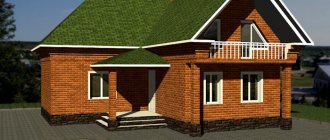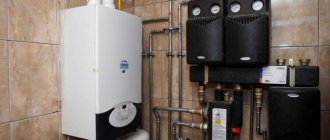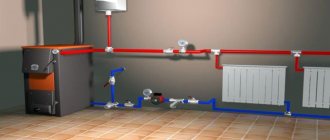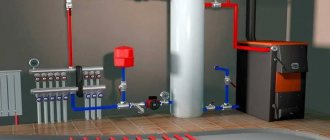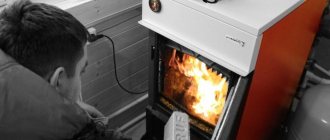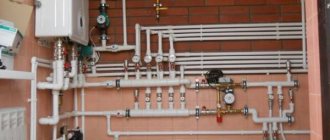During the winter period in Russia, housing needs to be heated even in the southern regions, which determines the demand among our consumers for many types of stationary and portable heating equipment. A large niche in the Russian market of heaters offered by foreign and domestic manufacturers is occupied by a group of infrared devices with a general principle of influencing the environment, but consisting of subgroups that differ in design and, as a result, functionality and efficiency.
Let's take a closer look at one of the types of infrared devices for heating homes - a wall-mounted film heater, which has been used in everyday life relatively recently, but, due to a number of advantages, is already in stable consumer demand.
Operating principle of IR heaters
Infrared rays are non-visible electromagnetic waves with a length from 0.74 microns to 1.5-2 mm. Any heated body becomes a source of infrared radiation - an emitter, and the emitter is heated by converting the energy of one of the types of energy carrier - electric current, gas, solid or liquid fuel - into heat.
Infrared radiation, encountering an obstacle in the path of propagation, causes vibration of its surface layer with an increase in the speed of movement of molecules, which causes an increase in the temperature of the object to a certain depth.
The wavelength range of infrared radiation, in turn, is divided into the following components:
- short-wave – 0.74-2.5 microns;
- average wavelength – 2.5-50.0 microns;
- long-wave – 50.0-2000.0 microns.
The intensity of heating of the surface of objects depends on the temperature of the emitter - the higher it is, the shorter the wavelength of infrared radiation and the greater the depth of heating of the surface of the obstacle. When IR rays propagate, they do not change the temperature characteristics of the transit medium - the air is heated not by their passage, but by the transfer of heat to it by heated objects.
The method of heat transfer through infrared radiation is not associated with conduction or convection, so IR heaters are capable of transferring heat even through a vacuum.
Calculation of infrared heating performance
To accurately calculate an infrared film heating system, you will need information about the following parameters:
- the total area of the house and each room where the system is supposed to be installed;
- number of window openings and their sizes;
- method of thermal insulation of foundations and walls;
- what electrical power is allocated to the building.
If we talk about an approximate determination of the required power, we can take as a basis the statement that for heating a house that is well insulated from the outside, 50 W/hour is sufficient for each meter of area heated by infrared ceiling elements. But this figure is average.
The included thermostat helps to optimally balance the load.
In reality, to warm up a cold room to +20° C, at the initial stage a power of up to 180 W/hour per square meter is required. m. In the future, the automation will switch to the mode of maintaining a constant temperature and will consume no more than 15 W/hour. This once again demonstrates that it is not for nothing that film heating is called energy-saving .
Ceiling heaters produced by factories of film heating systems, as a rule, have a power of 125 W and 150 W (per 1 m² of film surface). If we take a power of 150 W/m² for calculations, then with an average consumption of 50 W/hour we will get that 1 m² of heat emitter can heat 3 m² of room.
Although the ceiling version of infrared film heating consumes less electricity than floor IR heaters, it is necessary that peak loads do not exceed the capabilities of the home electrical network.
The table shows the permissible loads on the wiring:
| Wire material | Wire cross-section (mm²) | Permissible load (A) |
| Copper | 1,5 | 12 |
| 2,5 | 20 | |
| Aluminum | 1,5 | 7,5 |
| 2,5 | 12,5 |
Film electric heater device (PLEN)
*
All IR heaters are divided into high-temperature short-wave and low-temperature long-wave. Film-type heaters belong to the second group.
Visually, a film IR electric heater is a flexible sheet or strip of a certain format. If the model is not decorative (a picture heater), then the transparent outer layers allow you to see the location of the component elements.
Important! PLEN is an abbreviation meaning “film radiant electric heater”, and not a registered trademark.
Structurally, any type of film-type household heater includes the following components:
- resistive type heating elements - made of carbon-containing materials or metals, tape or plate, capable of heating up to 35-55 degrees when an electric current passes through them;
- heat distributing base - one or two layers of thin aluminum foil on which resistors are mounted to evenly distribute the heat from their heating over the surface of the screen;
- thermostat with temperature sensors;
- two protective layers of laminated film with a melting point of up to 210 degrees, between which there is foil with heating elements;
- cable for connecting PLEN to the network.
The total thickness of the heating sheet does not exceed 1.5 mm.
Schematically, PLEN can be depicted as follows (the thermostat is installed separately):
1 – contacts for connecting the device to a 220 V network;
2 – flexible two-layer shell made of polymer film on a supporting lavsan or polyester base;
3 – points of industrial, carefully insulated connection of the supply wire with the contacts of the heaters (independent cable replacement is not provided);
4 – heating resistive elements (tape or separate plates connected by conductors);
5 – aluminum foil;
6 – hologram to protect the heater from counterfeit production.
Connection
It’s not hard to figure out how to connect an infrared heater - it operates on a 220-230 V network, so the simplest and most obvious way is to plug it into an outlet. At least, mobile models are connected to sockets.
Panels or film systems are connected to each other in parallel, then connected to the thermostat (control panel), after which the wire (phase, neutral and ground) is pulled directly to the machine located in the distribution panel. This allows you to bypass all the wiring brought into the apartment or house. Most often, a separate automatic machine is installed to heat the apartment, which is triggered when there is a heavy load or a short circuit. The rest of the wiring in the apartment is connected to another machine. This allows you to correctly distribute the loads generated during the operation of infrared heaters. If you “hang” a powerful heating system on the existing apartment wiring, then when the heating system and, for example, an electric oven, air conditioner or iron are operating simultaneously, overloads are possible. In rare cases, this leads to a fire, although most often automatic devices are triggered.
However, to create a cozy warm corner with a small number of panels with a total power of up to 2 kW, it is possible to connect an infrared heater to an outlet, that is, the general electrical wiring in the house.
Operating principle of PLEN
*
When the power cable is connected to the network, the resistive elements heat up to a preset temperature value (35-50 degrees) within 10 seconds. Film heaters for non-domestic purposes (for mini-saunas, dryers of agricultural products), used in rooms with ceiling heights of more than 3.5 m, have resistive elements of wire, tape, plate design made of nichrome, fechral or multicomponent alloys, providing a higher temperature heating
The heat of the heaters is transferred to the foil and, due to the high thermal conductivity of aluminum, is evenly distributed over its surface, which allows the heater to generate IR radiation of equal intensity over its entire area. When the air in the room reaches the set temperature value, the film heater turns off based on a signal from the temperature sensor in the thermostat, and objects heated by radiation continue to give off heat. When the temperature in the room drops by 1 degree, the thermostat will turn on again, and the film heater will perform a new radiation cycle.
A correctly calculated combination of the material of the reflective layer, its thickness, and the arrangement of resistive heaters ensures the conversion of electricity into heat, and then into infrared radiation with a wavelength of 8-15 microns favorable for human perception.
Important! When the current increases or the thermostat fails, the temperature of the resistive graphite heaters will increase, which will lead to their destruction and failure of the household film heater as a whole, that is, the resistive elements also perform the protective function of fuses.
Film heaters
Film heater
Film IR heaters are devices used for general or partial heating of a room. They consist of film, foil and heating elements that produce long-wave infrared radiation. The devices also have special sensors that turn off the system when the air temperature reaches a predetermined level, and when it drops below the minimum acceptable level, the heater is activated. Thanks to this, electricity is saved - the device does not just work.
Some film heaters have thermostats with the ability to program the temperature for 24 hours. In this case, while there are no people in the room, the IR device does not turn on, and some time before the owners return, the device starts working and manages to warm up the house. However, such heaters cost significantly more than simple models.
Types of film heater
One of the main differences between film-type electric heaters is their format and size. PLENs are produced in the form of tapes of various lengths and widths. Independent correction of the dimensions of such films is impossible, therefore PLENs are produced in a wide range of dimensions, allowing you to choose the best option. The most common sizes of tapes in width are 35, 51 and 65 cm.
Films with a width of 35 and 51 cm have two zones that are free from the location of resistive elements and are intended for installation using a stapler - along the edges. Ribbons 65 cm wide have three such zones - two at the edges and one along the middle (as an option - two at the edges and between them transverse with a certain pitch).
Flexible film IR heaters can be installed on both vertical and horizontal surfaces - the design of film-type electric heaters does not depend on the location of its installation, with the exception of PLEN-pictures, which by definition should be located in places of the best view - on the walls. The classification of a particular film heater as a wall, floor or ceiling device is determined only by its design location - an important factor affecting the efficiency of this IR device. Thus, a film heater on the wall, after being installed on the ceiling, in everyday life turns into a ceiling heater.
Let's consider options for placing PLENs in premises in order of increasing efficiency of their use.
Wall arrangement of film heaters
*
Placing PLENs on the wall is the least effective due to the limited sector of influence of infrared radiation on the enclosing structures - most of the infrared rays heat the surface of the wall opposite, with almost no effect on the floor and ceiling.
Film devices permanently mounted on the wall are effective as the main means of heating only if the opposite base has a significant area - then the heat transfer from its heated surface into the air will be quite noticeable.
If the area of film heaters installed on the wall is not significant, and the base, on the contrary, also has window openings, then the efficiency of such an IR heater will be low. But small-area stationary wall-mounted film heaters are convenient as an additional means of heating - to increase the comfort of the temperature regime of a certain place or zone in the room.
A type of film-type wall heaters are portable IR devices with artistic decoration that imitate paintings. In order for their use to be rational and effective, picture heaters must be used in small rooms for heating, for example, a workplace, or in groups, the total heat transfer area of which will be commensurate with the size of the room.
Floor placement of film-type IR heaters
Infrared radiation from devices located in this way affects the floor covering and ceiling. A warm floor surface increases the comfort of human contact with it - you can walk without shoes, sit or lie on the floor, etc. In addition, the transfer of heat from the floor to the cold lower layers of air in the room also warms the room, as it causes the occurrence of convective flows. But the energy of that part of the IR rays that penetrates the floor covering is spent on heating the ceiling, which is less efficient - the ceiling base has little need for this, since its temperature is already quite high as a result of convection.
Important! It is not advisable to place film IR heaters in furniture locations - bulky objects made of materials with low thermal conductivity create barriers to infrared radiation.
Ceiling installation of infrared film heaters
When using film-type heating devices as the main means of heating, placing them on the ceiling is the most effective, since this arrangement ensures that all enclosing structures of the room, regardless of configuration, and the objects in it are exposed to radiation.
Important! When choosing a ceiling for installation of PLENs, it is necessary to take into account that the efficiency of heating with IR rays decreases with increasing distance to the emitter. Film-type infrared heaters are low-temperature, long-wave devices, so their use at ceiling heights of more than 3.5 m is irrational.
The advantage of ceiling placement of PLENs, in addition to high heating efficiency, is the minimal risk of accidental damage to the heater, which is located at a fairly safe distance from the traffic zone. However, there are also disadvantages - the location on the ceiling makes the PLEN vulnerable to leakage from above, and installation work at height is more labor-intensive.
Carbon fiber rod floor
Contrary to advertising brochures, this is not a new generation of carbon fiber technology: rod mats have not replaced film carbon. This configuration is used where film cannot be used (poured into a screed or self-leveling floor). It is a set of parallel connected hydrocarbon rods with an admixture of graphite and silver, connected in parallel.
Technologically, the heating element is not even a rod. A bundle of carbon fiber threads is assembled to the required diameter and securely covered under insulation. The shell material conducts heat well and protects the material, which is quite fragile to fracture, from mechanical loads during installation and use.
Graphite threads combined with carbon and silver, when electric current passes through them, emit infrared waves. The material allows one to calculate the resistance with precision and obtain the necessary thermal characteristics.
Since each rod is connected independently (on parallel buses), the failure of one (or several) elements will not affect the performance of the system. Unless there will be less heat. However, the installation method (pouring into concrete) implies high requirements for reliability. Unlike carbon film, these heaters cannot be simply replaced; you will have to destroy the entire surface of the screed.
Since the system is a monolith with an overlap, it is necessary to take care of the direction of thermal radiation (infrared waves). They diverge evenly in all directions, so when laying it is necessary to provide a screen on the back side.
Otherwise, a significant part of the energy will be spent on heating the neighbors below (or the basement in a private house).
An interesting feature of carbon rods is their ability to self-regulate temperature. When overheated, the resistance decreases and the rod cools down somewhat. This allows you to install heaters over the entire area of the room, without highlighting the location of the furniture. This is very convenient, especially given the inability to reconfigure the location of the thermal mats after the concrete has hardened.
Characteristics of an electric heater of film construction.
When choosing a film IR heater, you must be guided not only by its size - PLENs also have other characteristics, including those that are important for specific conditions:
- voltage of current consumption is mainly 220 V, but they are also produced at 110 V;
- power - up to 500 W, energy consumption per square meter of film heater (power density) can range from 70 to 170 W;
- maximum heating temperature – 35-50 degrees;
- current consumption – 0.7-1.2 A;
- specific gravity – up to 350 g/m2.
To make the description clearer, we summarize the data on the characteristics of film heaters in relation to their standard sizes:
*
What it is?
There are many modern materials on the market that perform the task of heating elements. One of them is infrared film, which is capable of emitting heat. This device consists of three layers, each of which performs its own task. It is worth noting that the film can be used not only for local heating, but also to equip the entire house with it. As for the principle of operation, it consists in emitting long infrared waves that heat hard surfaces that are located throughout the room, due to which the air is heated, so the temperature will be optimal and you can create comfortable conditions for living and working.
She works great and gets the job done. Such heating products are in great demand as they have a number of advantages.
Installation of film-type IR heaters
Installation of flexible film heaters, regardless of the installation location, does not require the contractor to have high-level professional skills, but must be carried out in compliance with the following rules:
- the installation site of the PLEN must be level and dry;
- cutting rolls, if provided for by the model, should be performed only according to the markings specified by the manufacturer;
- testing the functionality by plugging in a rolled-up heater is prohibited;
- the length of one strip film fragment should not exceed 8 m;
- adjacent strips of the heating system are located at a distance of at least 5 mm;
- bending the PLEN at an angle of more than 90 degrees is not allowed;
- installation of the film to the base is carried out with staples using a construction stapler or special fasteners (the use of ordinary nails and self-tapping screws is not effective);
- It is prohibited to carry out installation work at sub-zero air temperatures - after warming up the room, the film strips will increase in size and form folds.
Sequence of installation of film IR heaters
To protect against overheating, the base for placing the PLEN must be equipped with a foil reflective screen that acts as a heat and water insulator, for example, penofol, isolon.
The protective coating is mounted on the base with an overlap of adjacent edges of 3-5 cm; to speed up the process, it is advisable to use special fasteners for fastening, which are available in a wide range on sale.
From above, the joints of the screen strips are glued longitudinally with special foil tape.
The elements of the film heater are mounted on top of the laid screen - after preliminary layout and in accordance with the installation instructions supplied with the device. Installation is carried out taking into account the rule - for 1 square meter of flexible film there should be 8-10 fastening elements.
When the heating circuit is ready to be installed, it is connected to the thermostat, which should be located at a height of 1-1.5 m from the floor, and the system’s functionality is checked.
In addition, to correctly monitor the temperature in the room, the thermostat must be located away from other heating devices, have a thermal insulation pad underneath, and be protected from direct sunlight and drafts.
If the results of testing the IR device are positive, finishing materials are laid - floor covering or suspended ceiling, which are installed with a gap of 10-15 mm between the cladding and the film.
Important! There are no materials that are absolutely transparent for PLENs - any finishing finish on top of the film is a screen that attenuates radiation to one degree or another.
Read on the topic - how to attach, lay and glue penofol.
Calculation of PLEN energy consumption using the example of a house of 100 square meters. m
Our homes lose the most heat through windows, doors, floors and roofs. By choosing the best building and finishing materials, you can save a lot on heating costs.
We have already calculated how much film is needed. But will heating really “eat up” so much electricity? In fact, the costs will be small. Firstly, PLEN heating does not work around the clock - it turns on and off, obeying the thermostat. And secondly, infrared heating is economical. Therefore, the costs will not be very high.
If the house has good thermal insulation, then PLEN will work for about 10-15 minutes per hour . Based on the average cost of 1 kW of energy at 4 rubles, the cost of round-the-clock operation for a house of 100 sq. m would be 960 rubles per day. If the heating runs for 10 minutes, the daily consumption will be only 160 rubles. This will cost approximately 4,800 rubles per month.
By taking care to eliminate heat losses, you can ensure a significant reduction in space heating costs.
Some notes and recommendations for use
- One should not expect high efficiency from film IR heaters, as well as from any other heating units, in the absence of thermal insulation of the housing enclosing structures.
- Marketers' statements about the PLEN wavelength of 8 microns, supposedly optimal for human perception, do not correspond to reality - the radiation of IR heaters is always in a certain range and cannot consist of waves of any one length.
- Installing PLEN in one room, even over the entire area of the enclosing structures, will not solve the problem of heating other rooms for the house.
- The operation of PLEN is not accompanied by a decrease in oxygen in the room air, so there is no need to increase the frequency of room ventilation when using film heaters.
- It is not necessary to turn off the PLEN system in the summer - just set the thermostat to the desired temperature value.
- The durability of infrared film heaters declared by manufacturers (up to 50 years) is a hypothetical value, since PLENs began to be produced relatively recently.
- The safety requirements for household electrical appliances, including film-type ones, are set out in GOST R 52161.2.96-2006.
Manufacturer's choice
The characteristics of PLEN are approximately the same, since the same production technology is used, so statements about the advantages of a particular brand are not always reliable. PLEN has proven itself well, in particular EVO 300; you can buy this film in almost any large city, even Khabarovsk or Irkutsk. There are also many good reviews about Fracarro and Orient heating plates.
However, it should be taken into account that energy-saving technologies do not stand still, so new products regularly appear on the market that make it possible to reduce heat loss, and, accordingly, electricity consumption. Therefore, when designing alternative heating systems, this issue should be carefully studied.
Caleo GOLD 230-0.5 230 W
Thin infrared film rolled into a roll. Mat length – 200 cm, width – 50 cm. Heating area – 1 m². Power consumption 230 W. The film is protected from overheating. It is fireproof (has the ability to self-extinguish).
Advantages:
- easy to install;
- heats up quickly;
- warms up large surfaces well;
- turns on and off using a thermostat.
Flaws:
- Doesn't warm up the loggia well enough, but maintains the heat.
Home Guardian Angel
The wall heater adds warmth and coziness thanks to the image of a guardian angel.
Heating area - 15 sq.m, power 220 V, maximum heating -100 C. Can be used in an office, garage, loggia, apartment. Attached to the wall with screws.
Advantages:
- does not dry out the air;
- does not burn oxygen;
- decorates the room;
- creates heat;
- does not burn;
- can work around the clock;
- consumes little electricity.
Flaws:
- No.
